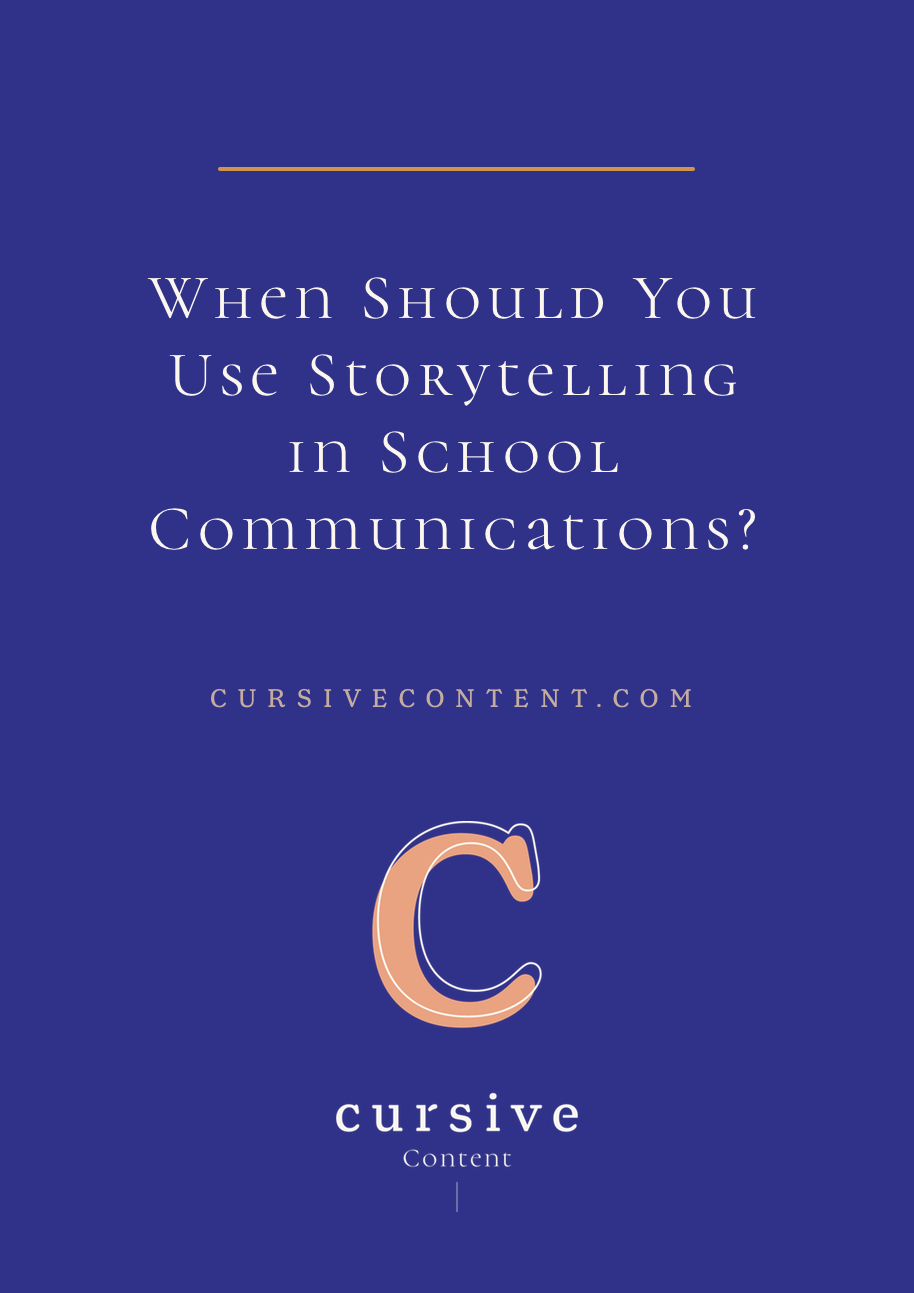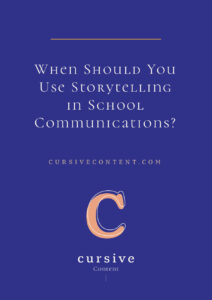When Should You Use Storytelling in School Communications?

We talk a lot about storytelling and how creating compelling and emotional content is the best way to connect with your audiences … but is it always appropriate?
Sometimes, the facts can and should speak for themselves. Your audience wants to know the exact tuition cost, or the number of students who receive financial aid, or the deadline for application. And you want this information to be transparent and incredibly clear.
But other times, at different points in your audience’s decision-making process, the facts are not enough.
You need your communications to build trust, or create community, or persuade. And you do that through storytelling.
So when should you use storytelling in your school communications? When will telling a story help you reach your goal and make an impact?
Here are 6 times when storytelling is appropriate and effective in school communications:
#1: When you need to change minds.
If you know your audience has wrong or negative connotations about your school or a specific program, the facts may not be enough to change their minds. Instead, you need to persuade them to think differently by telling a story so compelling they can’t ignore it.
The most in-our-faces example of this: our current political climate. Both parties are crafting stories for their candidates that depict who they and what they stand for. Their political ads tell stories of how they will succeed and the other will fail. In politics especially, the person with the most compelling (and believable) story often comes out on top.
#2: When you need to build interest.
If you’re talking, presenting or reaching out to an audience that is not already captivated, storytelling is a great way to earn their attention.
Think about the best in-person presentations you’ve attended. The strongest are the ones that begin not with the presenter simply diving into the topic at hand, but with the individual telling a personal story. Stories warm up the audience, build an emotional connection, and demonstrate who that person is and why she or he should be trusted.
(Hat tip to School Marketing Communication’s podcast episode “71: Interview with Gabrielle Dolan – The Power of Storytelling“. Take a listen if you want some really fantastic examples of how to incorporate storytelling into public speaking.)
#3: When you need to prompt action.
Want to raise money? Push that parent to press “submit” on that application? Have someone sign up for your email communications? Tell them a story.
The nonprofit charity:water is spectacular at this. It creates artful and emotional videos (and written content) that demonstrate not only the need it fulfills, but also the impact you can have by getting involved. Here are some powerful examples:
- “Completed Projects” proves every project it completes by tracking every dollar raised.
- charity:water trailer depicts how desperately our world needs clean and safe drinking water.
- Rachel Beckwith’s Last Wish emotionally shows how one person can make a huge difference.
#4: When you need to give an example.
If you’re trying to provide your audience with an example of results (say, student outcomes or the impact of donation funds), tell a story that demonstrates those results.
Show how that disinterested teen was transformed into an honor student who went on to an amazing profession. Show how each dollar was used to build your new science lab — and what impact that lab has had on your student’s interests and outcomes. When you show, not tell, your example is more believable and relatable.
#5: When you need to inspire your team.
Your coworkers are working hard every day at their own specific tasks. But storytelling can be a great way to remind them of the bigger picture — the outcomes and impact to which their daily work contributes.
The next time you get together to update your team on the latest numbers, or campaign results, or student statistics, think about how you can incorporate storytelling into your meeting. Perhaps it’s you telling a story about the impact — or, it’s inviting your coworkers to share their own.
#6: When you want to explain who you are.
Yes, you need to have your school’s positioning statement — but do you have a positioning STORY? Storytelling is a great way to explain who you are and to bring your brand attributes to life.
Those are my top 6, but there are of course many, many more. Storytelling is a way to excite, engage, inspire and build a true connection. If you’d like to read more about the power of storytelling, check out these articles:
- Does Your School Website Tell The FULL Story? If Not, Here’s How to Fix It.
- How This Head of School Became “Head of Storytelling” — and Increased Inquiries by 50%
- 4 External Factors That Should Influence Your Story
- How to Criticize Your Own Story (& Why You Should Do It)
- 5 Quotable Storytelling Lessons from Serial’s Sarah Koenig & Julie Snyder
- How Storytelling & Digital Marketing Helped This University Increase Enrollment By 41%
MORE ARTICLES
-
 Clarity in 50 Words or Less: How to Write Your School’s One-Sentence Story
Clarity in 50 Words or Less: How to Write Your School’s One-Sentence Story -
 The 4 Building Blocks of a Strong School Story (and Why AI Needs Them)
The 4 Building Blocks of a Strong School Story (and Why AI Needs Them) -
 How to Stop ChatGPT from Making Your School Sound Generic
How to Stop ChatGPT from Making Your School Sound Generic -
 What Should Your School Do with Its Blog Now That AI Is Changing Search?
What Should Your School Do with Its Blog Now That AI Is Changing Search? -
 What Is Your Private School’s Bold & Unifying Big Promise?
What Is Your Private School’s Bold & Unifying Big Promise? -
 Viewbook Best Practices for Private Schools
Viewbook Best Practices for Private Schools -
 AI Writing Prompts to Power Private School Storytelling
AI Writing Prompts to Power Private School Storytelling -
 How to Write a Magnetic Private School “About” Page
How to Write a Magnetic Private School “About” Page


